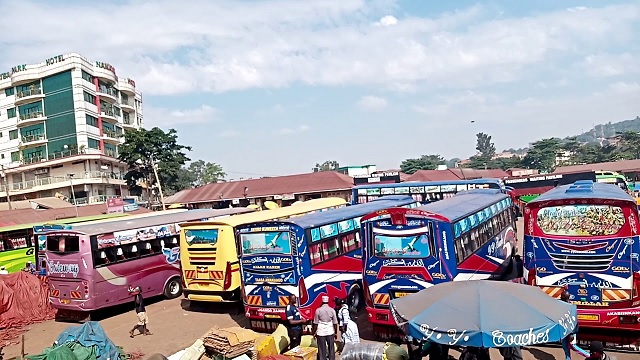
Kampala, Uganda | THE INDEPENDENT | Rising fuel prices have driven a quarter of Uganda bus companies out of business and half of the buses off the road. The bus companies offering public transport in Uganda have started closing business due to their inability to break even.
Of the over 80 operational bus companies in the country, at present not more than 60 are in operation, and the situation has escalated since January, based on the Uganda Bus Owners Association-UBOA information. The Ministry of Transport says there are 90 registered companies operating in the country but URN has only managed to count 80.
Many bus operators interviewed by URN have indicated that the future of passenger transport is simply bleak as they are making both gross and net losses, with a litre of diesel having doubled in price in the past year.
Some of the bus companies that have ceased operating at the time are Saviour coaches, Bwizi coaches, Lyantonde coaches, Zahura coaches, Dk coaches, Horse coaches, Stairway 5 coaches on the western route.
On the eastern route, it is Salama transporters, Kampala hoppers, Teso coach Wanagon, and Gogolo coaches, and this leaves the route with Kakise bus, Gateway in the park and YY which operates its own terminal outside those grounded.
The northern route is not different from others, with companies like Yapo, whose proprietor has even converted one of three vehicles to fetch cargo in the DR Congo. Other closed companies on this route are Acanadiro, Pacific Gulu, Baby coach Lira.
Umar Ddungu, the UBOA manager for the western route bus companies, says that bus companies started closing business since lockdown though at a slow rate, and in some cases are operating with limited vehicles.
Ddungu adds that the situation has worsened in the last six months since January when the fuel prices started increasing, and within this period alone, 7 companies have ceased operations, though they have not come out to officially deregister themselves from the association.
The cause of this problem to Ddungu is the increased operating costs due to fuel price hikes, coupled with the low passenger turn up, passengers who are not even willing to pay the increased transport fare, and this is making it hard for them to keep in business.
Without mentioning names, Ddungu says that as other companies are completely not in operation, those which are persisting have grounded some of their vehicles and are operating at half capacity, adding the general statistics from UBOA indicate that the industry is operating at 55% of recent.
“Though I will not give you the names of individual companies that have closed shop, the situation is very hard for us, and up to 45% of the total vehicle number is grounded.” he explains. The transport ministry says there are one thousand passenger buses in the country, which means 450 buses are grounded. From these, then subtract those that are being reconverted to carrying cargo, which their chasis was originally designed for in the first place. Most buses operating in Uganda were built on lorry and lack the safety attributes that a passenger bus should have.
As this general picture of the industry reflects such a performance, individual operators with whom URN has interacted, are crying foul about the same.
Dawuda Kigoongo, a bus driver plying the Kampala-Ishaka route, says that currently, the fuel costs have risen to 1.5 million shillings from 900,000 shillings, adding passengers are few as well and in most cases, they leave the park at half capacity and find the meaning of filling up along the way.
According to Kigoongo, this has greatly reduced their returns and when expenses are subtracted, survival becomes difficult;
Huzairu Taiwan, a driver plying Kampala-FortPortal-Bwera, says that the only reasons they are still doing this are the attachment they have with their customers and also the hope that one-day things will turn out to be better. He adds that as a company, they have also grounded 4 of their vehicles and are now using two.
He adds that unlike in the past, a bus can only collect money to fuel it for a single trip without return, and the operator has to figure out how and when to come back to Kampala.
Patrick Ekima, a driver along the Kampala Soroti route, says that generally bus transport business has of late turned to charity which is merely helping out people, adding that previously a bus used to make a profit of between 500,000 to 1 million shillings on a return trip, but as of nowadays, they hardly make any money.
Although the world is rapidly switching from combustion fuel to electric-powered vehicles, there are still currently very few electric buses in Uganda, all designed and built in the country by Kiira Motors Corporation, together with the national military industries-NEC.
The first two electris buses in Uganda, the Kayoola electric buses have been on the road for over two years. They have each clocked about 50,000 kilometres while mostly deployed in the Civil Aviation Authority to ply the Airport – City route.
Conversion from diesel/petrol to electric mobility is the world’s most urgent goal as far as rolling back the climate change crisis caused and worsened by carbon emissions in the air.
However, Ukraine crisis that has seen a sharp rise in fuel prices this year has added urgency to the need to switch to electric vehicles. Uganda spends about $2 billion a year on fuel imports and spare parts for its fuel combustion vehicles which are brought into the country when they are already very old.
On the other hand, the country loses a huge amount of electricity that is generated but not consumed due to low demand.
But worse still, the country has to pay for all the generated electricity/capacity, and also to peep servicing the loans acquired to build the dams and stations for generating the (unconsumed) power.
Switching to electric transport would provide more demand for electricity and relieve the taxpayer of the burden of paying for the unconsumed power and the loans.
*****
URN
 The Independent Uganda: You get the Truth we Pay the Price
The Independent Uganda: You get the Truth we Pay the Price



Electric cars are becoming cheaper. Time to install charge stations in all the towns.